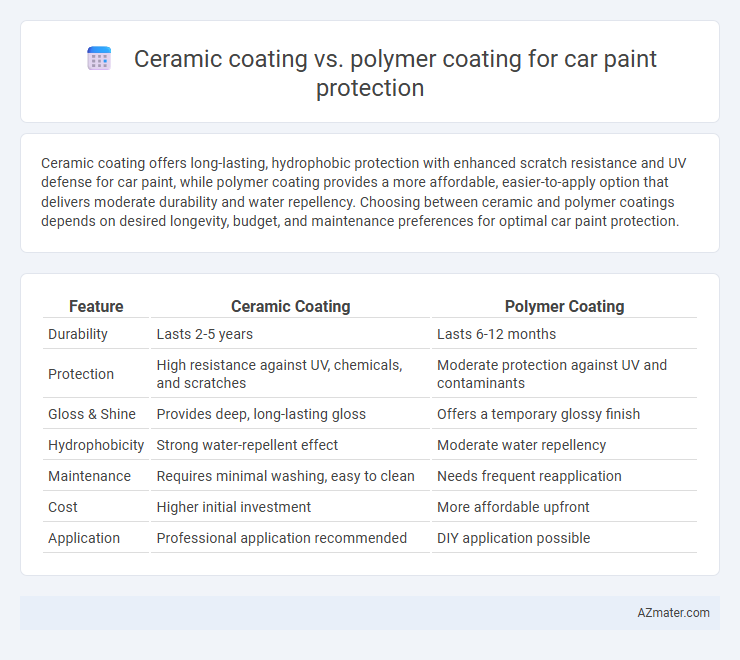Ceramic coating offers long-lasting, hydrophobic protection with enhanced scratch resistance and UV defense for car paint, while polymer coating provides a more affordable, easier-to-apply option that delivers moderate durability and water repellency. Choosing between ceramic and polymer coatings depends on desired longevity, budget, and maintenance preferences for optimal car paint protection.
Table of Comparison
| Feature | Ceramic Coating | Polymer Coating |
|---|---|---|
| Durability | Lasts 2-5 years | Lasts 6-12 months |
| Protection | High resistance against UV, chemicals, and scratches | Moderate protection against UV and contaminants |
| Gloss & Shine | Provides deep, long-lasting gloss | Offers a temporary glossy finish |
| Hydrophobicity | Strong water-repellent effect | Moderate water repellency |
| Maintenance | Requires minimal washing, easy to clean | Needs frequent reapplication |
| Cost | Higher initial investment | More affordable upfront |
| Application | Professional application recommended | DIY application possible |
Introduction to Car Paint Protection
Car paint protection uses advanced coatings like ceramic and polymer to shield vehicle surfaces from environmental damage such as UV rays, oxidation, and chemical stains. Ceramic coatings create a durable, glass-like layer that offers superior scratch resistance and hydrophobic properties, extending paint life and enhancing gloss. Polymer coatings provide a flexible, cost-effective barrier that enhances water beading and protection but typically require more frequent reapplication than ceramic coatings.
What is Ceramic Coating?
Ceramic coating is a liquid polymer applied to car paint that chemically bonds to the surface, creating a durable, hydrophobic layer that enhances scratch resistance and UV protection. This coating forms a semi-permanent shield against environmental contaminants, reducing oxidation and maintaining the paint's glossy finish for years. Unlike traditional waxes or sealants, ceramic coatings offer superior chemical resistance and longevity, making them a preferred option for long-term car paint protection.
What is Polymer Coating?
Polymer coating for car paint protection is a synthetic paint sealant composed of advanced polymers designed to bond with the vehicle's surface, providing a durable and flexible protective layer. Unlike ceramic coatings that rely on silicon dioxide (SiO2) for hardness and gloss, polymer coatings offer superior hydrophobic properties and scratch resistance by forming a thick, elastic barrier against dirt, UV rays, and chemical contaminants. This technology enhances paint longevity and ease of cleaning, making polymer coatings a cost-effective alternative with faster application and reapplication cycles compared to ceramic coatings.
Durability Comparison: Ceramic vs Polymer
Ceramic coatings offer superior durability compared to polymer coatings, typically lasting between 2 to 5 years with proper maintenance, while polymer coatings generally last 6 to 12 months before requiring reapplication. The chemical structure of ceramic coatings forms a harder, more resilient layer that provides enhanced resistance to scratches, UV damage, and chemical stains. Polymer coatings, while less durable, are easier and quicker to apply, making them a cost-effective option for short-term paint protection.
Protection Against Environmental Elements
Ceramic coatings provide superior protection against environmental elements such as UV rays, acid rain, bird droppings, and road salt due to their advanced nanotechnology that creates a strong, durable, and hydrophobic layer on the car paint. Polymer coatings offer good resistance to dirt and water but are generally less effective than ceramic coatings in preventing oxidation and chemical etching over time. For long-lasting defense against harsh weather, pollutants, and contaminants, ceramic coatings are the optimal choice for automotive paint protection.
Ease of Application and Maintenance
Ceramic coating offers a more durable and chemically resistant layer but requires professional application with meticulous surface preparation, making it less convenient for DIY enthusiasts. Polymer coatings are easier to apply, often available as spray-on products that bond quickly without complex prep, allowing for simpler maintenance and faster reapplication. Both protect against UV damage and minor scratches, but polymer coatings typically demand more frequent upkeep to maintain optimal performance.
Cost Efficiency and Value for Money
Ceramic coating offers superior durability and long-lasting protection, typically costing between $500 to $2,000, making it a cost-effective investment for extended paint preservation. Polymer coating, with prices ranging from $150 to $400, provides decent protection at a lower upfront cost but requires more frequent reapplication to maintain results. Evaluating cost efficiency, ceramic coatings deliver better value for money over time due to their enhanced resistance to scratches, UV damage, and chemical stains, reducing the need for costly paint repairs.
Appearance and Gloss Differences
Ceramic coatings provide a deeper, glass-like gloss that enhances the paint's reflective properties and creates a mirror-like finish, making colors appear richer and more vibrant. Polymer coatings offer a moderate shine with a softer, more natural look, maintaining the paint's original texture while providing a protective layer. The long-lasting hardness of ceramic coatings resists environmental contaminants better, preserving the glossy appearance longer compared to the more flexible, but less durable, polymer coatings.
Longevity and Reapplication Frequency
Ceramic coatings provide superior longevity for car paint protection, often lasting between 2 to 5 years with proper maintenance, due to their nano-ceramic particles that form a durable, hydrophobic layer. Polymer coatings typically last 6 to 12 months and require more frequent reapplication to maintain effective protection, as they form a thinner, less resilient barrier. The extended durability of ceramic coatings reduces the frequency and cost of reapplication, making them a preferred choice for long-term automotive paint preservation.
Choosing the Best Coating for Your Car
Ceramic coating offers superior durability with a lifespan of up to five years and excellent resistance to scratches, chemicals, and UV damage, making it ideal for long-term car paint protection. Polymer coatings provide a more affordable, easier-to-apply option that enhances gloss and provides moderate protection, typically lasting one to two years. Assess your budget, desired durability, and maintenance commitment to choose between the high-performance ceramic coating and the cost-effective yet reliable polymer coating.

Infographic: Ceramic coating vs Polymer coating for Car paint protection
 azmater.com
azmater.com